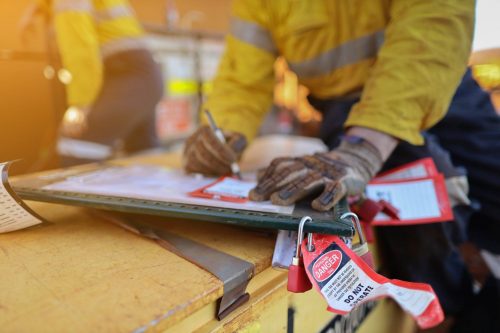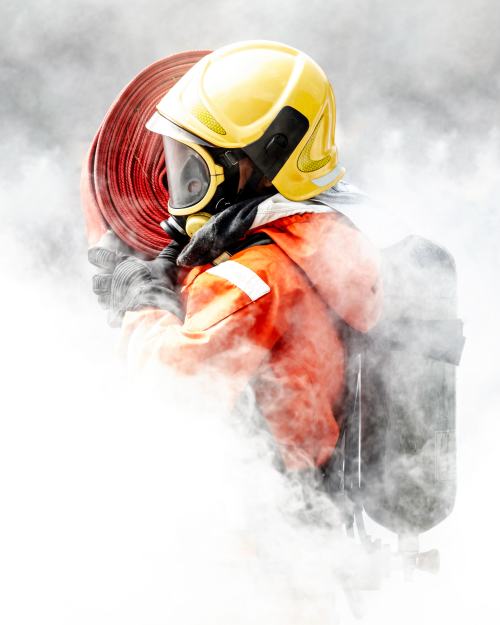
OSHA/CCOHS Approved Hazard Assessments for North American Businesses
OSHA and CCOHS hazard assessments have a lot in common. So today we’re going to compile hazard assessment tips from both OSHA and CCOHS so your team can work at ease in North America.
Overview
Both OSHA and CCOHS agree on the crucial steps to a formal hazard assessment. Yet the order is slightly different. Below are the OSHA steps, but proceeding with your assessment in this manner does not exclude any suggestions from CCOHS. They are very similar, and this order will satisfy both. These steps include:
Step #1 – Compile company-wide data.
Step #2 – Pinpoint safety hazards present.
Step #3 – Identify chronic health hazards
Step #4 – Create a system that promotes incident investigations.
Step #5 – Develop Emergency Plans.
Step #1 – Compile Company-wide Data

Correctly compiling company-wide data necessitates considering various perspectives. One of the simpler methods is to request each employee to document the tasks, associated hazards, and concerns they encounter. During this process, clear communication of your objectives is crucial to ensure the employees feel at ease. Stress that the process is not to single out individuals but is purely for safety enhancement. Encourage extensive feedback, and value differing perspectives on the same task as they offer learning opportunities and mitigate generational bias.
Once you have gathered employee feedback, list every task within your facility that your staff might have overlooked. Compare your list with the team’s input and consolidate the hazards that you have identified but your staff didn’t mention.
OSHA refers to this step as “Collecting existing information about workplace hazards.” It aligns closely with the standards set by Canada/Alberta, with both targeting a comprehensive understanding of an organization and its associated risks.
Alberta distinguishes task collation from hazard identification, but adherence to both standards is ensured as long as both aspects are addressed, and no information is omitted.
Step #2 – Identify Safety Hazards
Now, this sounds a lot like step number one, but what OSHA specifically is looking for in step two is a physical walkaround by management. Both OSHA and CCOHS suggest that an inspection of the entire operation is the only way to be sure of all the hazards. OSHA suggests identifying workplace safety hazards, and this does not include chronic health complications. For this step, they are looking for immediate risks and acute hazards.
Examples could include winding machines, heavy equipment, and anything sharp, agile, or obvious. It is not unheard of to do both an acute and chronic investigation of hazards at the same time, but OSHA suggests separating these due to priority.

The CCOHS, on the other hand, separates its terms into harm and hazard. Harm is defined by CCOHS as, “physical injury or damage to health” and they define Hazard as “a potential source of harm to a worker.” These definitions do little to change your assessment. When identifying your hazards, elaborate on the potential effects regardless of terminology. This includes acute injuries and chronic, but we will cover more on chronic complications in the next step.
To comply with both CCOHS and OSHA suggestions, you should be documenting any potential for Harm in your tasks during this step. So, by this stage as per OSHA and CCOHS suggestions, you should have:
- Tasks Identified Within Your Organization
- Identified Associated Acute Hazards or “Harms” via observation
Step #3 – Pinpoint Health Hazards (OSHA) or Identify Hazards (CCOHS)
OSHA refers to them as health hazards, while CCOHS simply terms them as hazards. Nonetheless, both are alluding to hazards capable of instigating long-term illnesses and complications for team members. Such hazards induce chronic illnesses and are challenging to pinpoint since symptoms may not manifest until later. Chronic hazards may arise from exposure to substances like benzene gas, silica powder, and potent cleaning solvents. They may also manifest as ailments stemming from repetitive actions, such as carpal tunnel, arthritis, and stress. If these afflictions result from overexposure, both OSHA and CCOHS mandate their inclusion in your assessment.

The identification of such hazards demands thorough examination rather than a cursory glance. In this phase, it’s imperative to scrutinize the tasks, along with the chemicals, tools, and labor necessary to accomplish them. Actions like frequent bending, lifting, and rotating can all lead to injuries. The more effectively these risks are mitigated in each task, the more robust the hazard assessment will be. During your evaluation walk-around, examine the ergonomic and physical approaches your staff adopts for their roles. Consider whether industrial strength tables could reduce bending, whether machines could simplify tasks, or whether a job rotation policy would be beneficial. You will need to readdress these considerations in step 6, where control measures are developed.
When it comes to chemicals, silica powders, concrete or any substance handled in your organization, the SDS (Safety Data Sheet) must be reviewed to identify all the hazards. Things like insolation won’t cause an overt injury, but accrued exposure can cause cancer. Every potential hazard for each substance should be described in your SDS. If you’re unsure as to the risks, review your SDSs.
If your SDSs are up to date, you can pull all these documents and cross-reference them with your tasks. This should speed up the process. If you identify any missing SDSs, then you need to rectify them immediately.
Step #4 – Incident Reporting Systems
“OSHA strongly encourages employers to investigate all incidents in which a worker was hurt, as well as close calls (sometimes called “near misses”), in which a worker might have been hurt if the circumstances had been slightly different.”OSHA Incident Investigation
Incident reporting has been around for a long time, and it’s been growing in prevalence ever since. Incident reporting can be seen as a real-time focused hazard assessment tool. Employees who document near misses and incidents are influencing future countermeasures with ground-level data.

An incident reporting system is a system designed to keep track of all your reports and supply you with data that could mitigate future mishaps or even injuries. You can do this through a system using paperwork and physically speaking with each of your employees in order to include the many perspectives needed. Or you can use modern incident reporting software which automates much of the process. The choice is yours but what OSHA and CCOHS suggest is a thorough investigation including multiple perspectives. The days of a supervisor-only perspective have been proven faulty. It’s now encouraged to include (at the least) the injured opinions, an observer’s perspective, along with the supervisor’s opinions.
In order to utilize the incident system you’ve developed, you will probably require dedicated staff or software depending on the size of your company in order to extract and aggregate the data when required. The whole point of the reports is to supply first-hand data that assists in future decision-making. These decisions should make everything safer and generally more productive.
Step #5 – Develop Emergency Plans
The next step in OSHA’s recommended practices for hazard assessments requires a bit of imagination, the Emergency Action Plan. This plan is essential in preparing your staff for an emergency or nonroutine situation. This includes fires, weather events, and any other non-routine event.
When you craft your plan, both OSHA and CCOHS advise that you envision any emergency situations that could force your staff to stop work and exit the building. It is crucial to establish protocols for such events, with the most paramount being the designation of a meeting place for your staff.
As you select a meeting place, bear in mind that everyone will gather there and you will need to perform a head count once the staff assembles. Opt for a location free from potential hazards, typically a parking lot away from your building, and understand that the appropriateness of meeting places can vary depending on the nature of the disaster. For instance, a parking lot is not ideal during hurricanes or tornadoes, unlike scenarios involving a fire within the building.
Things to Consider When Drafting an Emergency Action Plan

- Potential workplace emergencies
- Methods to protect your employees during the event
- Ways to protect your property
- How to alert staff
- Evacuation Locations
- Roles and coordinators
- Accounting for employees (headcounts)
- Rescue plans
- Medical assistance
- Employee health information
- Training requirements for an emergency
OSHA and CCOHS suggest creating protocols with all these considerations in mind. During a real emergency, many of these protocols could save lives. If properly planned, you can rest assured your staff knows what to do. The headcount and meeting place are especially important due to the instant peace of mind you will receive when all your staff are accounted for.
Step# 6 Characterize Identified Hazards and Create Control Measures
Characterizing simply is a form of prioritizing. If you have few hazards, then you could simply begin implementing controls. Either way, your order should be as follows:
- Characterize your hazards into severity and type
- Develop control measures
- Verify the validity of control measures
This step is all about execution. Use all the data you’ve compiled to develop harmonious control measures. You may need to ask employees’ opinions again in this stage to make sure guards, guides, and safety measures do not create more hazards. It’s a good idea to visit the OSHA hazard and control to verify you are implementing time-tested strategies.
Additional Resources






























